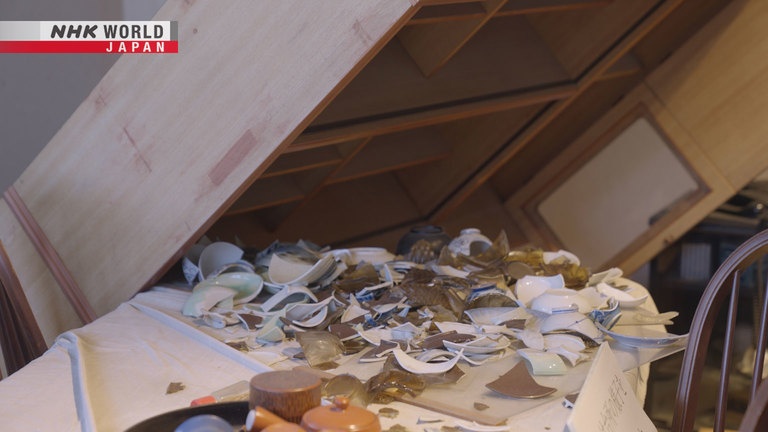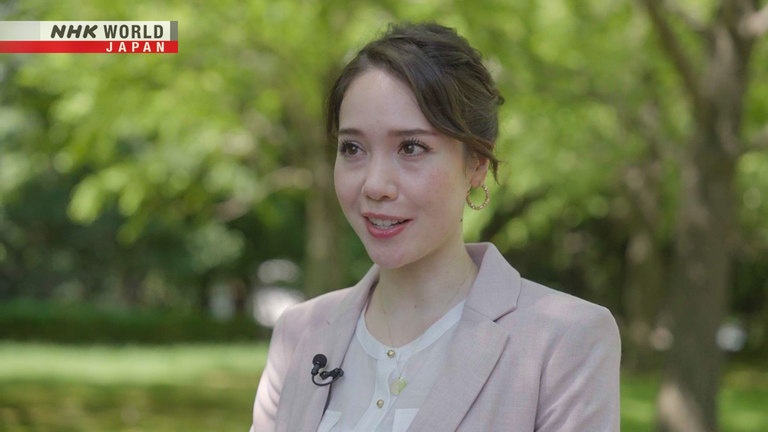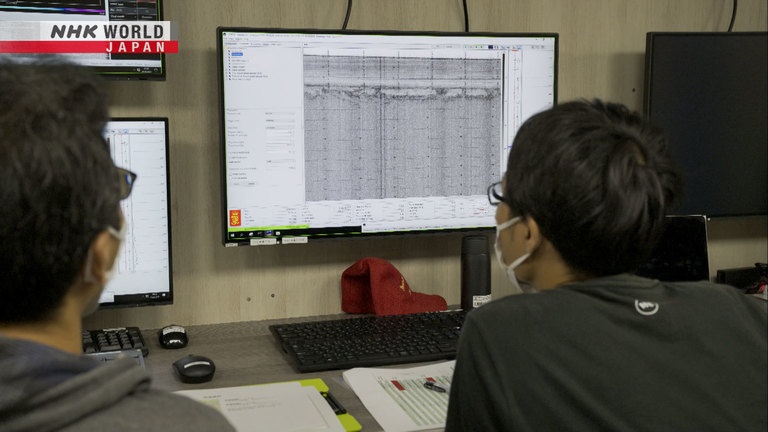#33 Active Faults
Earthquakes destroy many buildings and take lives. One cause of earthquakes is an active fault. The impact of a sudden displacement of the ground shakes the Earth and causes an earthquake. Japan has compiled a database of active faults found to date and is preparing for earthquakes by examining each one in detail to predict its magnitude. Surveys are also being conducted to find new active faults. In this episode, we'll see how one researcher is searching for active faults hidden in the seafloor by using ultrasonic waves sent out from a ship.




Transcript
Japan has a long history of natural disaster.
Now, the power of science is helping to overcome them.
"BOSAI
Science that Can Save Your Life."
Earthquakes. They strike suddenly and cause the earth to shake violently,
destroying houses and buildings, and causing an expressway to collapse.
One also caused great damage to this castle, a symbol of Japan.
In 1995, the Great Hanshin-Awaji Earthquake damaged approximately 250,000 buildings
and killed more than 6,400 people.
Where does this destructive energy come from?
And is there any way to limit the damage?
In this episode, we'll take a closer look at the latest research into understanding
how and where earthquakes occur.
Earthquakes cause the ground to shake and can lead to great damage and destruction.
But where does this vast amount of energy come from?
We may find the answer in that building over there.
Let's go and see.
We visited an earthquake museum located in the northern part of Awaji Island,
close to the epicenter of the Great Hanshin-Awaji Earthquake.
It preserves artifacts and materials from the disaster to show the quake's ferocity and destruction.
Wow! There's a strange cross-section of rock on display.
Yet the two sections have different colors, and have shifted diagonally along a fault line.
Okay, wow. So the earthquake actually caused the fault to slip this much.
You can see the color is totally different.
This is an excavated cross-section of what actually caused the earthquake: an active fault.
A fault occurs where the gradual buildup of tectonic forces
causes a fracture between rock layers, or "strata," producing a displacement.
Faults that are predicted to be the source of an earthquake in the future are called active faults.
This is the actual fault that caused the Great Hanshin-Awaji Earthquake.
The fault shifted up to 2.1 meters horizontally
and 1.4 meters vertically over a distance of approximately 10 kilometers.
It released a tremendous amount of energy, shaking the earth with a magnitude of 7.3.
This is Komeyama Masayuki, who experienced the earthquake.
Komeyama now travels all over Japan to pass on the story of the disaster.
This house was damaged by the disaster
and has been preserved as a memorial.
Fallen shelves and smashed dishes convey the sudden ferocity of the quake.
If I were in this situation,
I'd be unable to move.
I woke up to a loud thud, a jolt.
My wife cried out.
Before I knew it,
she was covering the children.
All I could do was crawl over
and do the same.
After 10 seconds of intense shaking, he finally got out of the house,
only to find the road covered with rubble and the wreckage of buildings.
If we found someone in the rubble
and they were still alive,
I'd cry with happiness.
If they were dead,
I'd cry with sadness.
There were about 3,700 houses in the area where Komeyama lived,
but nearly 3,300 of them were destroyed or damaged.
39 people died in this area alone.
The unexpectedly large earthquake made him think about the importance of disaster preparedness.
I regret being unable to do anything then,
because I wasn't prepared.
If I can save just one or two lives in the future,
I really want to pass on this message.
A major earthquake caused by an active fault is thought to occur once every 10 years.
We can prepare for future earthquakes by accurately mapping the location
and condition of these active faults.
Research is currently underway to help prepare for disasters
by studying active faults in detail.
Let's hear from a specialist.
- "Hello."
- "Hello."
I'm Lemi Duncan.
I'm Miyashita.
- Nice to meet you.
- Nice to meet you.
Yukari Miyashita conducts surveys of active faults all over Japan.
She excavates and investigates areas where active faults are presumed to exist.
Which active faults are you
currently looking at?
One is the Kego fault zone.
The Kego fault is a 55-kilometer-long fault that is found in the northern part of Kyushu.
Miyashita investigated the strata in detail and made an interesting discovery.
We found that earthquakes
occurred around 4,000 years ago,
and around 8,000 years ago,
which means the interval
is about 4,000 years.
So it's due for another to occur?
Yes, it's a possibility.
The Kego fault is nearing the "due date" for its next earthquake.
The fault line runs directly through Fukuoka,
a large city with a population of 1.6 million people, which may suffer severe damage.
If we know there's an active fault,
shouldn't we try to
build our cities elsewhere?
Where do the active faults
appear on the map?
They seem to be in places
where there are no mountains.
You're almost right.
Many are on the boundaries
between mountains and plains.
Active faults actually create
this kind of terrain.
Active faults cause earthquakes to occur repeatedly in the same location.
The ground moves upwards each time, creating a raised area.
The raised area is broken into small pieces by the earthquakes,
and the sediment accumulates on the lower side of the fault.
This creates the flat land on which cities develop.
What can we do to
limit these dangers?
It's important to know where
active faults are located,
and what the area
around them is like.
After an excavation survey has been conducted, Miyashita holds tours for local residents
so that they can learn about the active faults in their area.
I want people to know there are traces of very
large earthquakes beneath their neighborhood.
I want them to understand
what I've found.
I'm conducting research and
surveys in hopes that
the people living there will realize that
earthquakes may occur in the future.
In Japan, the government and research institutes are investigating active faults across the country.
They are particularly focused on over 110 active faults
which have the potential to cause major damage.
For eight of these active faults,
the probability of an earthquake occurring within 30 years is over 8%,
adding a degree of urgency.
While research into known active faults is progressing,
in recent years there have been a number of earthquakes
that may have been caused by unknown active faults.
When an earthquake struck Osaka in 2018, damaging more than 60,000 buildings,
the active fault that caused it had not yet been identified.
We don't yet know where all the active faults are located,
so the latest technology is now being used to find them.
Dr. Tetsuo Matsuno of Kobe University is searching for unknown active faults, and noticed something about the ocean.
If the fault is in the ocean, it may be preserved
for thousands, or tens of thousands, of years.
Faults on the land can be eroded by wind and rain,
making it difficult to obtain information about them.
However, faults in the ocean are often covered with mud
and may be preserved for tens of thousands of years.
Therefore, Matsuno decided to search for faults that might be hidden underwater.
Using ultra-high-definition sensors, he carried out a survey in 10-centimeter increments
to a depth of 40 meters below the sea bed.
A sonic sensor on the ship's hull emits a sound.
We measure the time it takes
for the sound to enter the rock layers,
and reflect back to the ship.
Matsuno surveyed Osaka Bay, where active faults had been predicted,
and the Harima Sea, where active faults had not yet been investigated.
First, he surveyed Osaka Bay in a mesh pattern of 2-kilometer intervals.
He made an interesting discovery.
There's a fault deep down.
One side has risen up and there's a
displacement in the strata.
He found a displacement of about 5 meters in the strata on the ocean floor.
This suggested a previously-unknown active fault.
And he found something even more surprising in the Harima Sea.
There was a displacement in the strata,
similar to Osaka Bay.
We don't think there was any previous research that
showed an active fault at this location.
Matsuno discovered signs of previously-unknown active faults.
Further investigations are continuing.
There are active faults in areas
that haven't yet been investigated.
We need to identify unknown active faults,
and improve the accuracy of our knowledge.
Active faults may lie hidden beneath our feet, and could cause a major disaster one day.
In Japan, we are trying to learn more about active faults,
and use this information to help prepare for future disasters.
Talking to researchers and getting a deeper understanding of the Earth's energy and the potential threat of
earthquakes really makes me want to do all that I can to prepare for the worst case scenario.
In our day to day lives, it's easy to get caught up with the tasks at hand
and not think of emergency situations,
but it's crucial that you check for any active faults in your vicinity and be prepared.